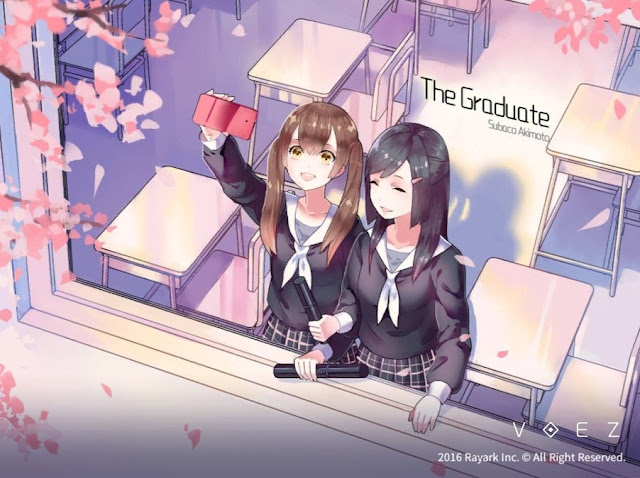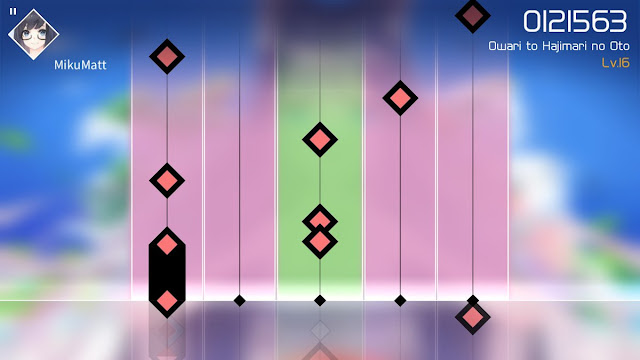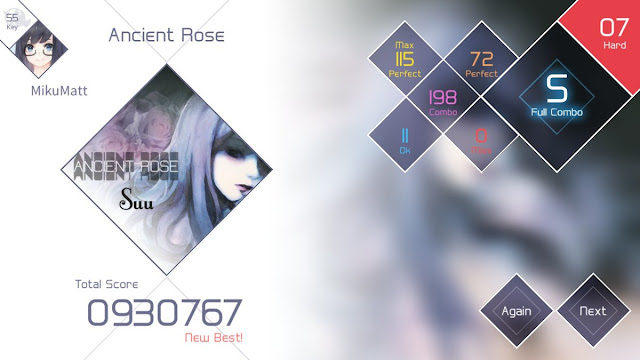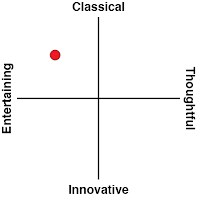Review by Matt S.
I didn’t think I could truly love a rhythm game that didn’t have Hatsune Miku in it. True story; I wasn’t even a fan of the genre before I played Project Diva on the Vita for the first time and was introduced to the green-haired angel, and while I’ve developed an appreciation for rhythm games since (not least of which includes Persona 4: Dancing All Night), I’d still have to say that the raw rhythm action in rhythm games still doesn’t appeal to me over the longer term; those rhythm games I am interested in are the ones that have, well, sexy characters in them.
Related reading: The best rhythm game of all time is Hatsune Miku Future Tone. Matt’s full review.
But then Voez came along and blew that theory out of the water. A pure-play rhythm game without much character beyond a stunningly elegant user interface, Voez is all about tapping the screen in time with the music, and I utterly love it. I loved it on mobile devices, despite a particularly nasty (and expensive) free-to-play model, and the requirement to be always online. I love it even more on the Nintendo Switch, where there’s a single upfront cost for the game’s 118-odd tracks, and you no longer need to be online to play the game. This is, by a significant margin, the superior version of Voez, one of the best rhythm games ever made, and the Nintendo Switch’s secret weapon. Everyone knows about Zelda. Not many are aware that the only console you can play Voez on is the Nintendo Switch, and that it’s as fine of an example of an exclusive as you could hope for on a console.
Voez’s rhythm game mechanics are simple; little icons fall from the top of the screen to the bottom, and you need to tap them as they hit the ‘ground,’ in time with the music. You get more points for being particularly accurate with the timing, and if you’re particularly out, the note registers as a miss. In addition to the tapping of icon “notes,” there are also moments where you’ll need to hold a finger over the screen, and others where you’ll need to drag your finger back and forth across the screen to reach all the notes.
The game is designed around multi-touch, and you’ll need your two thumbs (at least) to pass even the most basic of levels. For this reason you can’t play the game on the Switch through TV play, and it’s advisable to remove the Joy-Cons from the sides of the Nintendo Switch for the sake of ease of reach to the entire screen. Essentially you’ll be playing this one just like you would on a mobile phone, and I found the screen to be just the right size to allow the fingers to dart around the screen, while still being able to watch what was going on at all times (i.e. my fingers never got in the way of seeing the next icons coming up).
Your fingers will really dance on the screen, too. While it can be a little difficult to appreciate the brilliance of Voez on the easy difficulty setting (as is standard for rhythm games), once you amp things up to the higher difficulties, your fingers will need to fly across the screen as though you’re playing a musical instrument. The droppings icons have been “choreographed” perfectly with the music so that you’ll feel like you are, in fact, part of the musical performance itself. At that point, Voez stops being the overly abstract experience that it threatens to be at first and becomes a warm, deeply musical experience that is quite emotionally engaging.
The superb track list helps, too. With over 100 songs there are going to be tracks you simply don’t like, but this will be offset by plenty that you do, and this is a guarantee. The game offers a diverse range of genres, from gently lilting love songs, to graceful piano solos, right through to Asian pop music, electronica, and a bit of rock for good measure. As with any rhythm game the real longevity is in trying to master your favourite tracks, and the general difficulty of the game, coupled with its tracklist depth, means that you’ll not achieve that any time soon.
Because there’s no free-to-play mechanics at play, Voez instead relies its thing, but breezy story and unlock challenges to keep players interested, but the difficulty for these scales far to quickly. Each “challenge,” once completed, unlocks a panel of a visual novel of sorts, with some of the most elegant art you’ll ever see accompanying the limited text. It’s a lovely little narrative, calling to mind summer experiences and breezy youth, but after you’ve unlocked just a couple of panels the game starts throwing challenges like “score a B or better rating on the highest difficulty level.” You might think that a B-rating is easy, but it’s not on this “special” difficulty rating, even after you’ve spent hours and hours in the game. Trying to unlock these story panels eventually got to the point where it was frustrating enough that I gave up and went back to enjoying trying to better my score on the more comfortable (but still challenging) “Hard” difficulty setting.
Related reading: Persona 4 Dancing All Night is also really great. Matt’s full review.
If I could say more about Voez I would, but it really is a simply beautiful example of minimalistic elegance and functionality, refined to a near perfect degree. So many rhythm games offer such an abstracted experience, where you’re pressing buttons in time with the music, but you never quite feel like you’re a part of the music. With Voez, the choreography of the icons leaves you feeling like you’re playing an instrument and are involved in the performance of the music itself, and that is incredibly immersive and engaging. As I said at the start; this is the Nintendo’s secret weapon, because this is one very special game, and exclusive to the console (at least, in its microtransactions-free state), and it’s absolutely essential.
– Matt S.
Editor-in-Chief
Find me on Twitter: @digitallydownld










